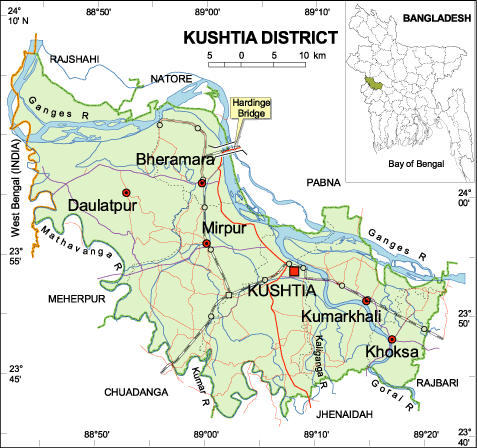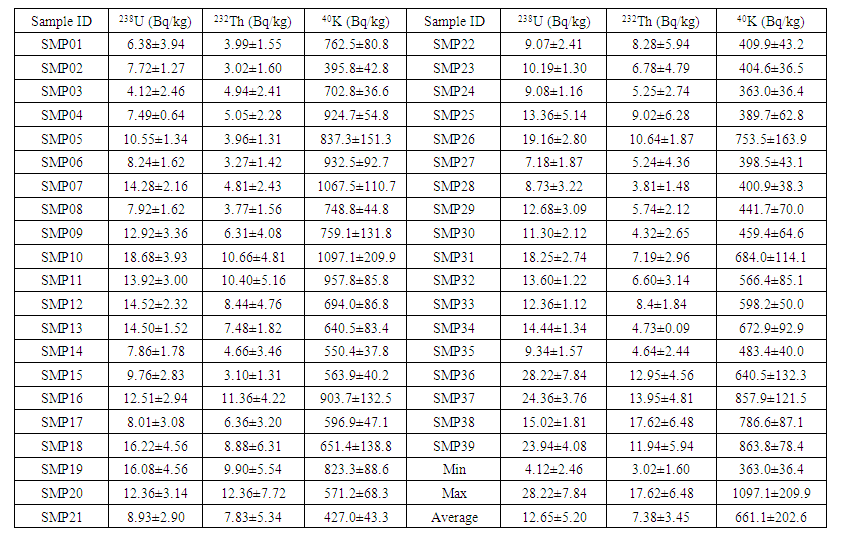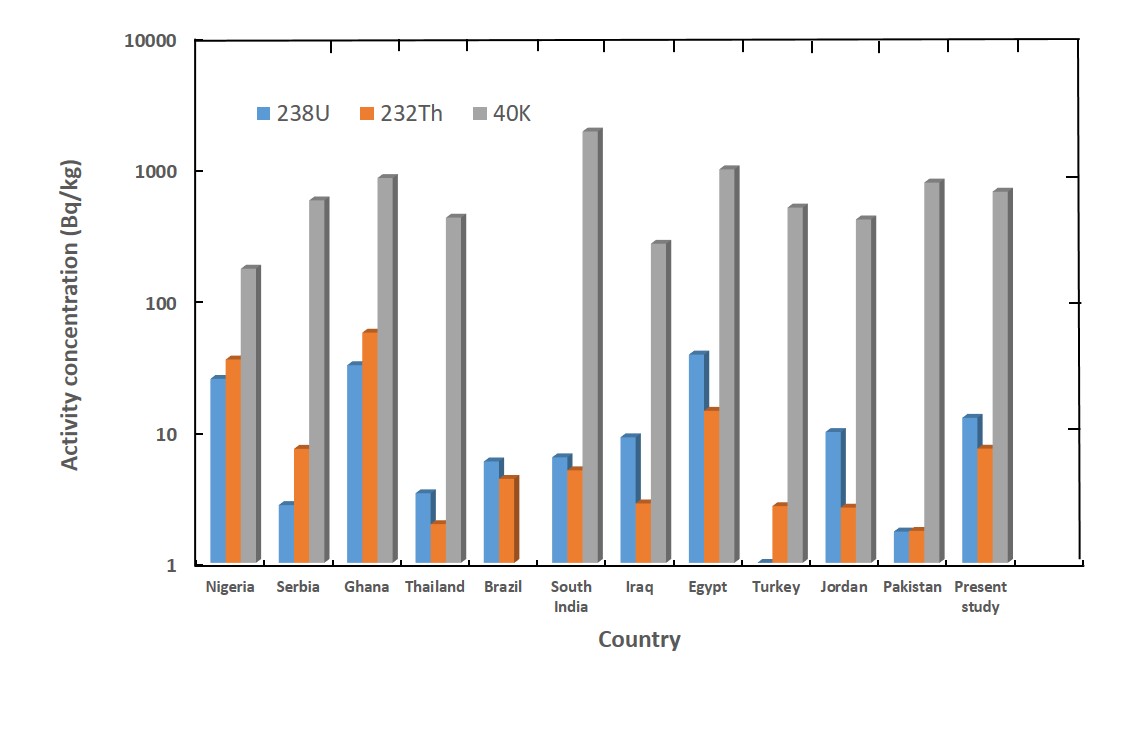-
Paper Information
- Paper Submission
-
Journal Information
- About This Journal
- Editorial Board
- Current Issue
- Archive
- Author Guidelines
- Contact Us
Journal of Health Science
p-ISSN: 2166-5966 e-ISSN: 2166-5990
2020; 10(1): 20-27
doi:10.5923/j.health.20201001.03
Received: Nov. 5, 2020; Accepted: Nov. 25, 2020; Published: Dec. 15, 2020

Natural Radioactivity and Hazards Assessment in Medicinal Plants in Bangladesh
S. Sultana1, J. Ferdous2, M. M. Haque1
1Department of Physics, University of Rajshahi, Rajshahi, Bangladesh
2Health Physics Division, Atomic Energy Center (AEC), Dhaka, Bangladesh
Correspondence to: M. M. Haque, Department of Physics, University of Rajshahi, Rajshahi, Bangladesh.
| Email: |  |
Copyright © 2020 The Author(s). Published by Scientific & Academic Publishing.
This work is licensed under the Creative Commons Attribution International License (CC BY).
http://creativecommons.org/licenses/by/4.0/

The radioactivity concentrations of 238U, 232Th and 40K in medicinal plants commonly used in Bangladesh were measured using High-purity Germanium gamma spectrometry. The potential radiation hazards associated with these medicinal plants were assessed by evaluating the absorbed dose rate, radium equivalent activity, external hazard index, annual effective absorbed dose and annual effective ingestion dose. The activity concentrations in the studied medicinal plants ranged from 4.12±2.46 to 28.22±7.84 Bq/kg, 3.02±1.60 to 17.62±6.48 Bq/kg and 363.0±36.4 to 1097.1±209.9 Bq/kg for 238U, 232Th, and 40K with the mean values of 12.65±5.20, 7.38±3.45, and 661.1±202.6 Bq/kg, respectively. The average annual committed effective doses for ingestion of natural radionuclides ranged from 6.29±1.24 to 18.17±4.64 µSv with an average value of 11.46±2.57 µSv, which is far below the world average value of 285 µSv/y reported by UNSCEAR 2000. This is the first time measurement of natural radioactivity of medicinal plants in Bangladesh. The present results are, therefore, expected to provide the baseline data for settling a safety standard and guideline for the utilization of these medicinal herbs in Bangladesh.
Keywords: Activity concentration, Gamma-ray spectroscopy, Medicinal plant, Radiological hazards
Cite this paper: S. Sultana, J. Ferdous, M. M. Haque, Natural Radioactivity and Hazards Assessment in Medicinal Plants in Bangladesh, Journal of Health Science, Vol. 10 No. 1, 2020, pp. 20-27. doi: 10.5923/j.health.20201001.03.
Article Outline
1. Introduction
- Naturally occurring radionuclide materials (NORMs) are found to be present in significant amounts in air, soil, rocks, plants, foods, recycled industrial waste-products and also in human body [1-4]. The NORMs in the environment mostly come from the decay chains of 238U and 232Th, and also from 40K [4-6]. Because of these natural radionuclides humans are continuously exposed to gamma radiation both externally and internally.Plants have formed the idea of sophisticated traditional medicine systems that have been in existence for thousands of years and continuing to provide mankind with new remedies. It has been reported [7] that about 70-80% of the world populations, particularly in the developing countries, primarily depend on the nonconventional medicine in their medical procedures. Accordingly, medicinal plants are increasingly used also in Bangladesh, mainly because they are readily available and cheaper than modern medicines. Varieties of medicinal herbs are grown in Bangladesh in different seasons. NORMs and their progeny present in these medicinal plants of Bangladesh may cause health hazards for the population. The assessment of radioactivity in different medicinal plants is, therefore, of great importance and interest in health physics not only for many practical reasons but also for more fundamental scientific reasons.The radionuclides present in the environment are transferred to the herbs through their roots from soil and through aerial parts by direct absorption. Qualitative and quantitative knowledge of the radioactivity level is important since it concerns the radionuclides liable to cause radiation protection problems under extreme conditions. Recently, plant researches have been increased significantly all over the world and the concentrations of NORMs in different medicinal plants have been measured by a number of experimental groups [8-14] to monitor radiation level in the environment. However, in Bangladesh, the systematic studies on the distribution and enrichment of radionuclides in medicinal plants are sparse. Depending upon the physiological characteristics of the plants a large variation is observed in the degree of translocation of radionuclides to herbs of different species. The measurement of natural radioactivity in medicinal herbs in Bangladesh perspective is, therefore, a significant research interest.The purposes of this study are to report on: (i) the activity concentrations of natural radionuclides 238U, 232Th and 40K in some selected medicinal plants in Bangladesh; (ii) the annual effective absorbed dose and the annual ingestion dose in order to evaluate the external exposure and the uptake of NORMs; and (iii) the radiological risk due to the consumption of the studied medicinal plants. Various techniques with different principles are available to determine the radioactivity levels in the samples. Gamma-ray spectrometry system is one of them. This technique is common to low-level radio-analysis and applicable to other environment contaminants as well. In the present study, the gamma-ray spectroscopy measurements were carried out with a high resolution HPGe detector in Health Physics Division, Atomic Energy Centre (AEC), Dhaka.
2. Materials and Methods
2.1. Sampling Area
- A total of 39 samples of medicinal plants, listed in Table 1, commonly used in Bangladesh were collected during October 2017 to January 2018 from the industrial area of Kushtia district, the western part of Bangladesh under Khulna division. With an area of 1608.80 square kilometers the district is located in between latitudes 23.90°N and longitudes 89.12°E and is situated at elevation 17 m above sea level. It is bounded by Rajshahi, Natore, Pabna districts to the north, by Chuadanga and Jhenaidah districts to the south, by Rajbari district to the east, Meherpur district to the west, and an international boundary to the West Bengal of India to the west. The main rivers: Ganges (Padma), Gorai, Mathabhanga, Kaliganga and Kumar are flowing through the district. The temperature varies between 37.8°C to 9.2°C and an annual rainfall average is 1,467 millimeters.
2.2. Sample Preparation
- The samples were washed with water to remove soil contamination and then dried under the sun. These samples were then crushed into small pieces, homogenized and dried again using an electric oven at 105°-110°C up to the time of achieving a constant weight. The dried samples were grounded to fine powder, meshed through 0.5 mm sieve and finally sealed into a Marinelli beaker. Before counting, the samples were left at room temperature for about 1 month so that the radionuclides 226Ra, 222Rn and their daughters attain at the secular equilibrium. The present study used dry mass of the samples to determine the radionuclide concentration. Table 1 lists the name (the traditional name as well as the scientific name) and the part of the medicinal plants studied.
 | Figure 1. Sampling location map of Kushtia district |
 | Table 1. Data of plant sample used in this study |
2.3. Measurements
- The concentrations of the natural radionuclides in the medicinal plants were measured using a gamma-ray spectrometer associated with a coaxial ORTEC HPGe detector connected to EMCAPLUS and computer with a program installed for data acquisition and analysis of the gamma-ray spectrum. The spectrometer was calibrated using the monoenergetic gamma sources 137Cs, 60Co and 40K as they emit gamma-ray energies over the entire energy-range of interest. The activities of 238U, 232Th and 40K were measured from the photo-peaks of their respective daughter nuclei. The measurement time for each sample was set at 10,000 s. All measurements were corrected from background radiations by counting an identical empty beaker for the same counting time.
2.4. Calculations
- We employed the following analytical expression [15] to evaluate the activity concentration A (Bq/kg) of individual radionuclide
 | (1) |
 Ts and M denote, respectively, the net counts of the photo-peak, the detector efficiency, the intensity of the gamma-ray energy, the sample counting time and the mass of the sample. Error associated with every calculation was measured by the standard deviation (SD) equation.Once the activity concentration of natural radionuclide is obtained the absorbed dose rate D in outdoor air at 1 m above the ground surface can be calculated by [4,16]
Ts and M denote, respectively, the net counts of the photo-peak, the detector efficiency, the intensity of the gamma-ray energy, the sample counting time and the mass of the sample. Error associated with every calculation was measured by the standard deviation (SD) equation.Once the activity concentration of natural radionuclide is obtained the absorbed dose rate D in outdoor air at 1 m above the ground surface can be calculated by [4,16] | (2) |
 | (3) |
 | (4) |
 | (5) |
 | (6) |
3. Results and Discussion
- The present study measured the radioactivity concentrations of NORMs in 39 different medicinal plants frequently used in Bangladesh using gamma ray spectrometer. The mean concentrations of 238U, 232Th and 40K were computed using Eq. (1). In order to estimate the potential radiation hazards due to the consumption of these medicinal plants various hazard index and annual effective doses were also evaluated using Eqs. (2)-(6). Our results were compared with the world average values set by UNSCEAR [4] and also with the data measured in other countries. Our results and comparisons are furnished systematically in the following sub-sections.
3.1. Activity Concentrations
- The dry weight average activity concentrations of 238U, 232Th and 40K in the medicinal plants measured in the present study are depicted in Table 2. The average activity concentrations of 238U was estimated by averaging the activities of its daughter radionuclides 214Pb and 214Bi. For 232Th, the activity concentrations have been estimated by averaging the concentrations of 212Pb, 208Tl and 228Ac. The 1461 keV gamma activity was used to determine the concentration of 40K in different samples. A wide range of activities is observed for each studied sample and radioisotope. The variations in activity concentration of NORMs among the medicinal plants may be attributed due to their radioactive mineral content and their ability to absorb particular elements [23].
 | Table 2. Specific activity concentrations of NORMs in the studied medicinal plants |
 | Figure 2. Comparison of mean specific activities of 238U, 232Th and 40K in medicinal plants among different countries |
3.2. Hazard Indices and Annual Effective Doses
- Various hazard indices and annual effective doses computed by using Eqs. (2)-(6) are presented in Table 3. Observably, the distribution of NORMs in the environmental samples including medicinal plants are not uniform. The index namely radium-equivalent activity Raeq has, therefore, been introduced to assess the radiological hazards from these non-uniform radionuclides. As shown in Table 3, the values of Raeq obtained in this study varied from 42.52±6.85 and 118.40±26.90 Bq/kg with the mean values of 74.10±13.92 Bq/kg. One can see that the present results of Raeq for all the studied samples are much lower than 370 Bq/kg recommended by the UNSCEAR [4].
|
 | Figure 3. Comparison of the annual effective ingestion dose with the reported series |
4. Conclusions
- An analysis of gamma rays emitting natural radionuclides i.e. 238U, 232Th and 40K in 39 medicinal plant samples frequently used in Bangladesh was performed using gamma-ray spectrometry. Though the elemental profile of some medicinal plants with vegetables of Bangladesh has been studied earlier, the activity concentration of the naturally occurring radionuclides in medicinal plant samples has been studied for the first time. The activity concentrations in the studied medicinal plants ranged from 4.12±2.46 to 28.22±7.84 Bq/kg, 3.02±1.60 to 17.62±6.48 Bq/kg and 363.0±36.4 to 1097.1±209.9 Bq/kg for 238U, 232Th, and 40K with the average value of 12.65±5.20, 7.38±3.45, and 661.1±202.6 Bq/kg, respectively. The mean annual effective doses due to both external exposure and ingestion of NORMs in the studied medicinal plants were found to be 116.10±20.63 and 11.46±2.57 µSv respectively. The present results were compared with their respective reference values as well as with those measured in other countries. The comparison showed that, in general, the radioactivity concentrations and their associated annual effective doses obtained in the present study were comparable with those of similar studies in other countries. The values were also found to be within the permissible limit recommended by UNSCEAR. The utilization of these medicinal plants in herbal treatment may, therefore, not produce any health hazard. The baseline data of the present study may be helpful, in future, to estimate the external and internal radiation hazards for the sake of human health.
ACKNOWLEDGEMENTS
- The cooperation of all stuffs of the Health Physics Division, AEC, Bangladesh is highly appreciated. M. M. Haque would like to thank Faculty of Science, University of Rajshahi for partial funding.
 Abstract
Abstract Reference
Reference Full-Text PDF
Full-Text PDF Full-text HTML
Full-text HTML